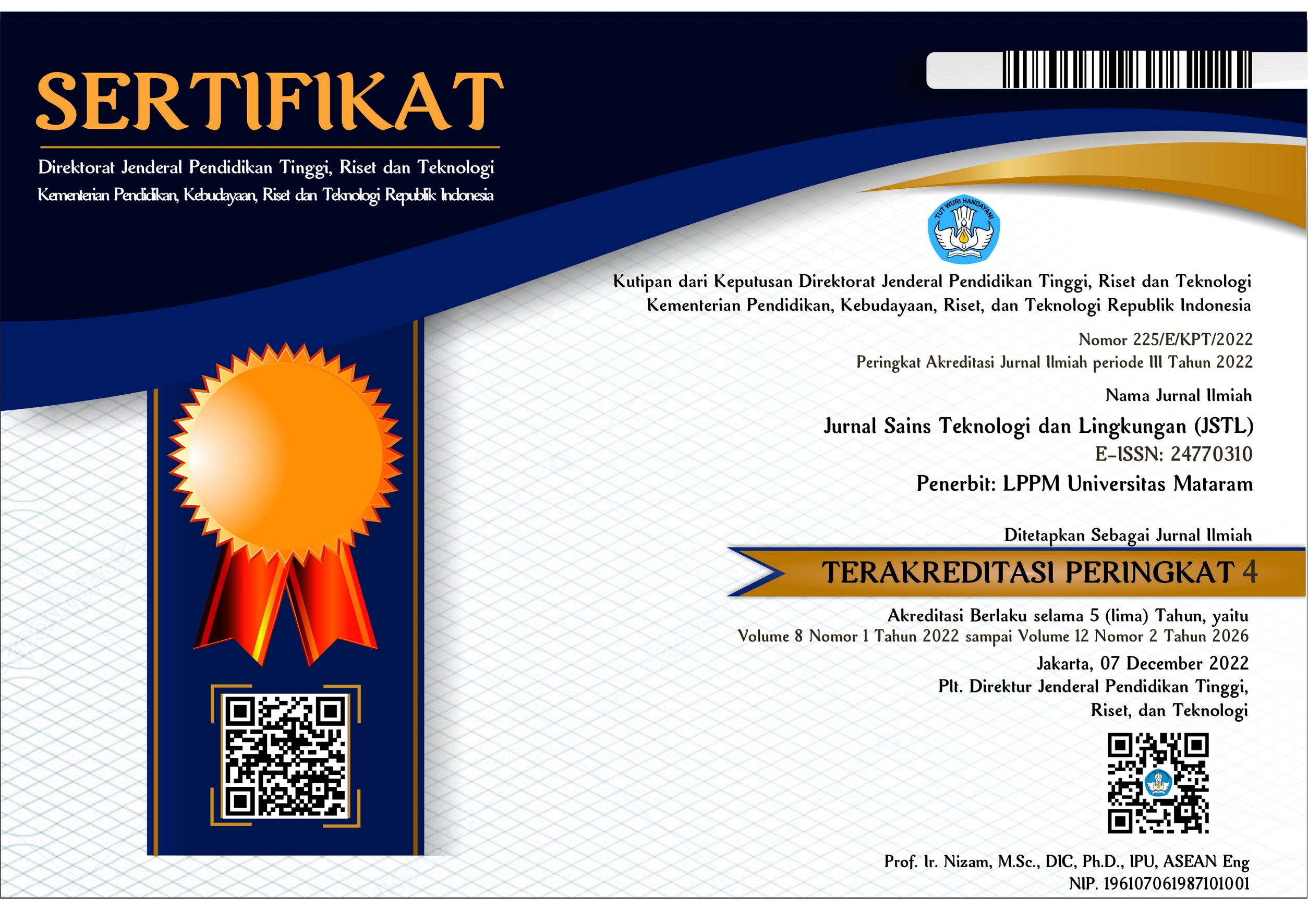Rancang Bangun Sistem Pendingin Air Nutrisi Berbasis Peltier untuk Optimasi Pertumbuhan Tanaman Hidroponik
DOI:
https://doi.org/10.29303/jstl.v11i2.856Keywords:
cooling system, nutrient chiller, TEC1-12706, vertical hydroponics, timer control, Peltier moduleAbstract
High ambient temperatures inside tropical greenhouses can significantly raise nutrient solution temperatures in vertical hydroponic systems, disrupting nutrient uptake and reducing plant productivity. This study focuses on the design and development of a nutrient cooling system (chiller) using two TEC1-12706 thermoelectric modules (Peltier) arranged in series to enhance heat dissipation performance. The nutrient solution is pumped from the reservoir to the cooling chamber using a 12 V DC pump and recirculated in a closed-loop configuration. The chiller system is fully automated, controlled by two DH48S digital timers operating simultaneously: one activates Peltier 1, while the other controls Peltier 2 via the NC output (5 minutes) and the pump via the NO output (30 seconds), enabling alternating programmed cooling and circulation. The entire chiller unit is active only from 08:00 to 18:00 WITA using a KG316T programmable timer, corresponding to peak thermal stress hours inside the greenhouse. Results showed that despite greenhouse temperatures reaching up to 39.4 °C with relative humidity dropping to 47.6%, the chiller system maintained nutrient solution temperatures within the optimal 27–30 °C range. This design proved effective in reducing and stabilizing nutrient temperature under high heat microclimates. With its simple, automated, and energy-efficient architecture, the chiller system offers a promising solution for small-scale vertical hydroponics and greenhouse-based urban farming in tropical regions.References
Ayob, N. A., Setumin, S., Fathoni, K., Ani, A. I. C., & Maruzuki, M. I. F. (2022). Development of an IoT-based Water Temperature Control and Monitoring System for Hydroponics. 2022 2nd International Conference on Emerging Smart Technologies and Applications (ESmarTA), 1–6. https://doi.org/10.1109/eSmarTA56775.2022.9935490
Cortella, G., Saro, O., De Angelis, A., Ceccotti, L., Tomasi, N., Costa, L. D., Manzocco, L., Pinton, R., Mimmo, T., & Cesco, S. (2014). Temperature control of nutrient solution in floating system cultivation. Applied Thermal Engineering, 73(1), 1055–1065. https://doi.org/10.1016/j.applthermaleng.2014.08.068
Dennison, M. S., Kumar, P. S., Wamyil, F., Meji, M. A., & Ganapathy, T. (2025). The role of automation and robotics in transforming hydroponics and aquaponics to large scale. In Discover Sustainability (Vol. 6, Issue 1). Springer Nature. https://doi.org/10.1007/s43621-025-00908-4
Fordyce, S. I., Carr, P. M., Jones, C., Eberly, J. O., Sigler, W. A., Ewing, S., & Powell, S. L. (2023). Sentinel-2-based predictions of soil depth to inform water and nutrient retention strategies in dryland wheat. Agricultural Water Management, 289. https://doi.org/10.1016/j.agwat.2023.108524
Hikashi, M., Ishikawa, K., Mori, M., & Yasutake, D. (n.d.). Control of Viscosity in Different Concentrations and Temperatures of Nutrient Solution for Hydroponic System.
Kawasaki, Y., Matsuo, S., Kanayama, Y., & Kanahama, K. (2014). Effect of Root-zone Heating on Root Growth and Activity, Nutrient Uptake, and Fruit Yield of Tomato at Low Air Temperatures. Journal of the Japanese Society for Horticultural Science, 83, 295–301. https://doi.org/10.2503/jjshs1.MI-001
Pasos-Panqueva, J., Baker, A., & Camargo-Valero, M. A. (2024). Unravelling the impact of light, temperature and nutrient dynamics on duckweed growth: A meta-analysis study. In Journal of Environmental Management (Vol. 366). Academic Press. https://doi.org/10.1016/j.jenvman.2024.121721
Sarbu, I., & Dorca, A. (2018). A comprehensive review of solar thermoelectric cooling systems. International Journal of Energy Research, 42, 395–415. https://doi.org/10.1002/er.3795
Tan, L., He, J., & Lee, S.-K. (2002). Effects of root-zone temperature on the root development and nutrient uptake of Lactuca sativa L. “Panama” grown in an aeroponic system in the tropics. Journal of Plant Nutrition - J PLANT NUTR, 25, 297–314. https://doi.org/10.1081/PLN-100108837
Thakulla, D., Dunn, B., Hu, B., Goad, C., & Maness, N. (2021). Nutrient solution temperature affects growth and◦ brix parameters of seventeen lettuce cultivars grown in an NFT hydroponic system. Horticulturae, 7(9). https://doi.org/10.3390/horticulturae7090321
Wu, B., Zuo, J., Niu, H., Jia, R., Li, Q., Chen, X., Yang, Z., Zhang, C., Sun, F., & Xi, Y. (2025). Transcriptome and metabolome analyses reveal the potential mechanism of root zone temperature regulates the growth rhythm of switchgrass (Panicum virgatum L.) seedlings. Industrial Crops and Products, 230. https://doi.org/10.1016/j.indcrop.2025.121041
Downloads
Published
Issue
Section
License

This work is licensed under a Creative Commons Attribution-NonCommercial-ShareAlike 4.0 International License.


1.png)











